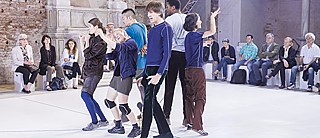In dance migration is not a phenomenon confined to modern times. For numerous reasons artists were and still are “travelling people”. And in many cases this professional mobility is neither voluntarily nor casually chosen as a working basis. Market laws, globalisation and/or societal mechanisms of oppression, censorship and violence are often the reasons for artists to leave their place of origin and seek the stylistic expanses of the world.
One of the first migrants of dance was Jean Georges Noverre (1727–1810). With his innovation programme for the establishment of ballet as dramatic stagecraft, he travelled indefatigably throughout Europe, searching constantly for patrons, audience, dancers and venues. A generation later it was the star dancers of the Romantic era such as Marie Taglioni, Fanny Elßler or Fanny Cerrito whose paths led them wherever the applause of the audience or the payment offered by the impresarios lured them - even to the young USA.
Historische Migration
Here one could perhaps speak of a European internal phenomenon, and a luxurious one at that. In the late 19th and early 20th century, the situation became more precarious. Animated by the media’s presentation of colonialism and certainly also inspired by the new science of ethnology, non-European styles of movement suddenly took centre stage. Japanese, Indonesian, Chinese, Chassidic or Indian dances became the attractions in the vaudeville programmes of European entertainment districts. They brought with them the dance groups, more or less respectfully admired. Many of these performances were, however, simply fabrications by European dancers who invented exotic biographies for themselves in order to tap into the market. No less a dancer than Margaretha Geertruida Zelle, better known under her Indonesian pseudonym Mata Hari, had to pay for this “fake migration” with her life: she was accused of spying and condemned to death in France in 1917.
Political Migration
This particular case owed more to the wartime propaganda of that era than to a criticism of exoticism. Some years later, however, there came a much more radical change in migration conditions. 1933, the year in which the National Socialists came to power, saw the beginning of political migration on a large scale as from this time on artists in Germany were only able to work under restricted conditions. So-called “Modern Dance” was not subjected to aesthetic “cleansing” as were the other arts - in the National-Socialist concept of culture there was no “degenerate dance”. Yet dance artists were also subjected to an ideological and racist regime that forced many into exile. Recent research has revealed how radical this artistic exodus from Germany was – and how stimulating it was outside Germany. It sounds macabre: German and Austrian modern dance had a far greater radiance and broader impact after 1933 and/or 1938. For the hundreds of expelled artists took this art form all over the world. Gertrud Bodenwieser now worked in Australia, Renate Schottelius in Argentina and throughout Latin America, Gertrud Kraus in Palestine or Israel, Sigurd Leeder in Chile. They all founded traditions of modern dance outside the European framework.
Moral Migration
Dance has frequently been morally controversial, also in most recent times. Depending on which religious, political and social system prevailed, dance was indecent, forbidden, celebrated or prescribed by the state. The rule of thumb could be: the more monotheistic-religious influence, the less dance. In the middle of the noughties, the productions
Letters from Tentland and
Return to Sender were much acclaimed. The choreographer Helena Waldmann had produced pieces with women from Iran, who under the conditions of the Islamic republic were not allowed to dance in public and therefore performed in large tents without showing themselves. And in times of war and fundamentalism, the Arab dance platform in Beirut has hardly any contemporary dance from the Arab core countries in its programme, whereas it does have a number of artists from the – mostly European – diaspora.
Economic Migration
It is not only in the case of the Arab countries that one can one talk of an artistic diaspora. Within a country as well as between states contemporary dance moves along the routes of funding, co-productions, residences and workshops. The European funding instruments – from the supranational cooperative programmes of the Commission to the subsidies of local administrations – have long since ceased to provide full financing. Hence projects can only be realised when several institutions join forces. For the artists involved this means that they have to move constantly from one rehearsal site to the next, from one guest performance to another, from one project discussion to the subsequent one. Within the European framework this functions fairly smoothly. But woe betide those who have to obtain visas for artists from third countries.
